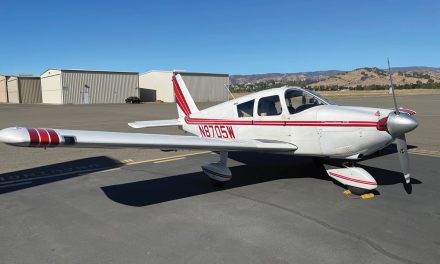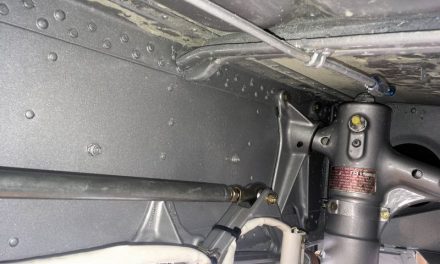
By Musa Mohammed and Michelle Adserias
“I love everything about the Piper Aztec and I wanted an airplane that could do all the things an Aztec could do. If Piper still made them, I would have bought a new one. But there is no such airplane these days, so I came to the conclusion that if I wanted a nice one, I would have to restore it myself.”

These were the words of Musa Mohammed when asked why he was determined to completely recondition a Piper Aztec. Musa said he was drawn to the Aztec because of “its useful load-carrying capacity, its short field take-off and landing capability, its range, its versatility, its ease of handling, its reliability, its safety and its ability to ‘take a lickin’ and keep on tickin’,’ to borrow a phrase.”
Once he decided on this restoration project, he spent months searching for the right plane. He found N7181Y, a 1980 Piper Aztec F model, in Indianapolis, Indiana in 2021.
Like most hard-working Aztecs, it showed its age. Aztecs were built to take a lot of abuse, one of the reasons they are a favorite for multi-engine flight training and almost always heavily worn.
It would be impossible to list all the details of the overhauls and replacements. Let’s just say, if it could be updated, it was. “Everything is done except for the exterior paint job. Literally everything was restored,” Musa said. “My invoice from JA Air Center (Aurora, Illinois) was 80 pages. You name it, it was restored or modified or replaced. Airframe, engines, interior, lights, avionics – all wires, buttons, plastics – everything.”
The Restoration Process
Bringing N7181Y back to its original glory wasn’t easy. Securing parts for the STC modifications was very challenging, at times. Finding the cowls was by far the most difficult. Musa is thankful JA Air Center was as excited about his project as he was. They managed to find the left cowl in Canada, and the right one in Ohio. They tracked down new ones because they needed to be cut and fitted, an STC modification that allows someone to take apart the cowls and gain complete access to the engine in 30 minutes, a job that would normally take many hours.
John Talmage, owner of Diamond Aire in Montana, sourced many of the parts and STC’s. Sadly, he recently passed away. And Chuck Walling, “who never met a part he couldn’t restore” was a crucial team member when parts were installed simply nowhere to be found. Because some parts were difficult to nearly-impossible to find, Musa wonders whether another Piper Aztec could be restored to this extent.
Given the option, Musa probably would have installed two new engines, but due to supply chain limitations during the COVID shutdowns, Musa was only able to secure one factory-new Lycoming engine. The other engine was overhauled at Poplar Grove.
When it came time to update the avionics, Musa followed Piper’s lead and installed mostly Garmin products. He chose the G500TXI, two GTN-750XI, three G-5 back-ups and a Garmin transponder. He is currently using a KFC-200 auto-pilot while he waits for Garmin to approve their GFC-600 auto-pilot, which should be available later this year. His Piper Aztec also has a JPI-960 engine and systems monitor and a carbon monoxide detector.

The only thing left is the paint job. Several years ago, Bob (Woodlake Aircraft Refinishing in Sandwich, Illinois) painted Musa’s PA- 32 Cherokee 6/300. “He did such a fantastic job that I couldn’t ever consider going anywhere else,” Musa explained. “We have something very special in mind for the paint job. Think Hot Wheels™.” But that will have to wait until Bob has an opening in his schedule next spring.
A Well-Matched Pair
Musa believes most kids dream of flying but, at some point, outgrow the dream. Pilots are people who chase their dream until they catch it. Musa’s first flying lesson was in 1997 at Chicago’s Midway Airport, where he flew N8334W, a Piper Cherokee PA-28-160. He’s been flying ever since.
Now that his Aztec is ready to take to the skies, he plans to use it for business. He’s in the intermodal trucking business and uses the Aztec to visit his out-of-state offices and clients. But he also uses it for pleasure trips. Musa loves flying to the East Coast. “The New York City skyline from the Hudson is breathtaking at night.”
Perhaps Musa’s tenacity throughout this restoration mirrors the tenacious nature of the Piper Aztec, a forgotten champion. It’s ruggedness has earned it the nickname “Aztruck.” They have been used to transport everything from families to freight. “Just ask any freight dogs from those days and they’ll tell you if the job was at night, over inhospitable terrain or through bad weather, give me an Aztec. I may not get there first, but I’ll get there for sure.” Most people think of a Baron or Cessna when they think of twin-engine aircraft. But Musa’s go-to is the Piper. “Give me an Aztec any day, especially one with all the bells and whistles.” With the modifications he’s made, Musa routinely reaches over 180 knots in cruise.
This enthusiastic pilot would recommend the Aztec to anyone considering a move to a twin engine aircraft. “It’s safe, docile and tough.”
If you would like to see more photos of the restoration process visit this YouTube post:
Piper Aztec F model restoration and modification project. Two years of progress in photos. (www.youtube.com/watch?v=sz8kKqh9jR8)
If you enjoy flight videos, Musa has a number of them on YouTube. Just search for PA27pilot.












